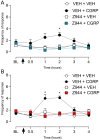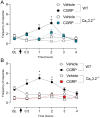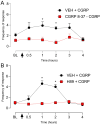CaV3.2 T-type calcium channels contribute to CGRP- induced allodynia in a rodent model of experimental migraine
- PMID: 39695919
- PMCID: PMC11656763
- DOI: 10.1186/s10194-024-01921-0
CaV3.2 T-type calcium channels contribute to CGRP- induced allodynia in a rodent model of experimental migraine
Abstract
Background: Migraine is a painful neurological syndrome characterized by attacks of throbbing headache, of moderate to severe intensity, which is associated with photo- and phono- sensitivity as well as nausea and vomiting. It affects about 15% of the world's population being 2-3 times more prevalent in females. The calcitonin gene-related peptide (CGRP) is a key mediator in the pathophysiology of migraine, and a significant advance in the field has been the development of anti-CGRP therapies. The trigeminal ganglion (TG) is thought to be an important site of action for these drugs. Moreover, experimental migraine can be induced by CGRP injection in the TG. The signaling pathway induced by CGRP in the TG is not fully understood, but studies suggest that voltage-gated calcium channels contribute to CGRP effects relevant to migraine.
Objective: We hypothesised that CGRP injection in the TG enhances CaV3.2 T-type calcium channel currents to contribute to the development of periorbital mechanical allodynia.
Results: A Co-Immunoprecipitation assay in tsA-201 cells revealed that CaV3.2 channels form a complex with RAMP-1, a component of the CGRP receptor. Constitutive CGRPR activity was able to inhibit CaV3.2 channels and induce a depolarizing shift in both activation and inactivation curves. Incubation of TG neurons with CGRP increased T-type current density by ~ 3.6 fold, an effect that was not observed in TG neurons from CaV3.2 knockout mice. Incubation of TG neurons with Z944, a pan T-type channel blocker, resulted in an approximately 80% inhibition of T-type currents. In vivo, this treatment abolished the development of periorbital mechanical allodynia induced by CGRP in male and female mice. Likewise, CaV3.2 knockout mice did not develop periorbital mechanical allodynia after intraganglionic CGRP injection. Finally, we demonstrated that the CGRP effect depends on the activation of its canonical GPCR, followed by protein kinase A activation.
Conclusion: The present study suggests that CGRP modulates CaV3.2 in the TG, an effect possibly mediated by the canonical CGRP receptor and PKA activation. The increase in T-type currents in the TG may represent a contributing factor for the initiation and maintenance of the headache pain during migraine.
Keywords: Calcitonin gene-related peptide; Electrophysiology; Mice; Periorbital mechanical allodynia; RAMP-1; Trigeminal ganglion; Voltage-gated calcium channels.
© 2024. The Author(s).
Conflict of interest statement
Declarations. Competing interests: The authors declare no competing interests.
Figures






Similar articles
-
Contribution of intraganglionic CGRP to migraine-like responses in male and female rats.Cephalalgia. 2020 Jun;40(7):689-700. doi: 10.1177/0333102419896539. Epub 2019 Dec 19. Cephalalgia. 2020. PMID: 31856582
-
Sex differences in behavior and expression of CGRP-related genes in a rodent model of chronic migraine.Headache. 2011 May;51(5):674-92. doi: 10.1111/j.1526-4610.2011.01882.x. Headache. 2011. PMID: 21521205 Free PMC article.
-
Expression and function of calcitonin gene-related peptide (CGRP) receptors in trigeminal ganglia of R192Q Cacna1a knock-in mice.Neurosci Lett. 2016 May 4;620:104-10. doi: 10.1016/j.neulet.2016.03.046. Epub 2016 Mar 25. Neurosci Lett. 2016. PMID: 27021026
-
CGRP and the Trigeminal System in Migraine.Headache. 2019 May;59(5):659-681. doi: 10.1111/head.13529. Epub 2019 Apr 14. Headache. 2019. PMID: 30982963 Free PMC article. Review.
-
CGRP in the trigeminovascular system: a role for CGRP, adrenomedullin and amylin receptors?Br J Pharmacol. 2013 Dec;170(7):1293-307. doi: 10.1111/bph.12129. Br J Pharmacol. 2013. PMID: 23425327 Free PMC article. Review.
Cited by
-
Roles of Ion Channels in Oligodendrocyte Precursor Cells: From Physiology to Pathology.Int J Mol Sci. 2025 Jul 29;26(15):7336. doi: 10.3390/ijms26157336. Int J Mol Sci. 2025. PMID: 40806469 Free PMC article. Review.
References
-
- Lipton RB, Bigal ME, Diamond M, Freitag F, Reed ML, Stewart WF (2007) Migraine prevalence, disease burden, and the need for preventive therapy. Neurology 68(5):343–349 - PubMed
-
- Headache Classification Committee of the International Headache Society (IHS) (2018) The International classification of Headache disorders, 3rd edition. Cephalalgia 38(1):1–211 - PubMed
-
- Stewart WF, Wood C, Reed ML, Roy J, Lipton RB (2008) Cumulative lifetime migraine incidence in women and men. Cephalalgia 28(11):1170–1178 - PubMed
-
- Vanood A, Rangel IC, Starling AJ (2023) Migraine and the gender divide. Neurol Clin 41(2):231–247 - PubMed
MeSH terms
Substances
Grants and funding
LinkOut - more resources
Full Text Sources
Medical
Research Materials
Miscellaneous

